
RAC体系为系统扩容开创了一条新的道路:只需要不断向集群Cluster中加入新的服务器就可以了。这里我们就来介绍一下如何为10g RAC Cluster增加节点;实际上这并不复杂,甚至可以说是很简单的。为现有的Oracle 10g RAC添加节点大致包括以下步骤:
- 配置新的服务器节点上的硬件及操作系统环境
- 向Cluster集群中加入该节点
- 在新节点上安装Oracle Database software
- 为新的节点配置监听器LISTENER
- 通过DBCA为新的节点添加实例
我们假设当前RAC环境中存在2个节点,分别为vrh1和vrh2;该RAC环境中clusterware和database的版本均为10.2.0.4,需要加入该Cluster的新节点为vrh3。
一、在新的服务器节点上配置操作系统环境
- 这包括配置该节点今后使用的public network公用网络和private network接口,不要忘记在hosts文件中加入之前节点的网络信息,并将该份完整的hosts文件传到集群Cluster中已有的节点上,保证处处可以访问
- 同时需要在原有的基础上配置oracle(或其他DBA)用户的身份等价性,这需要将新节点上生成的id_rsa.pub和id_dsa.pub文件中的信息追加到authorized_keys文件中,并保证在所有节点上均有这样一份相同的authorized_keys文件
- 调整新节点上的操作系统内核参数,保证其满足今后在该节点上运行实例的内存要求以及10g RAC Cluster的推荐的udp网络参数
- 调整新节点上的系统时间以保持同其他节点一致,或者配置NTP服务
- 保证原有Cluster中所有节点上的CRS都正常运行,否则addNode时会报错
- 配置clusterware和database软件的安装目录,要求路径和原有节点上的一致
二.向Rac Cluster中加入新的节点
1.在原有RAC节点上(vrh1)以oracle用户身份登录,设置合理的DISPLAY显示环境变量,并运行$ORA_CRS_HOME/oui/bin目录下的addNode.sh脚本
[oracle@vrh1 ~]$ export DISPLAY=IP:0.0 [oracle@vrh1 ~]$ cd $ORA_CRS_HOME/oui/bin [oracle@vrh1 bin]$ ./addNode.sh
3.在”Specify Cluster Nodes to Add to Installation”界面下输入公共节点名、私有节点名和VIP节点名(之前应当在所有节点的/etc/hosts文件中都配置了):
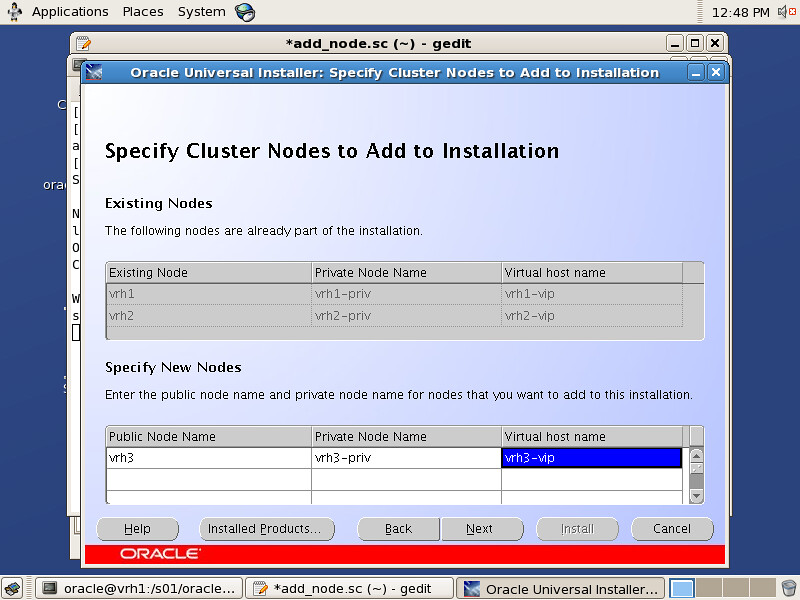
4.出现”Cluster Node Addition Summary”界面Review一遍Summary信息,并点击NEXT:
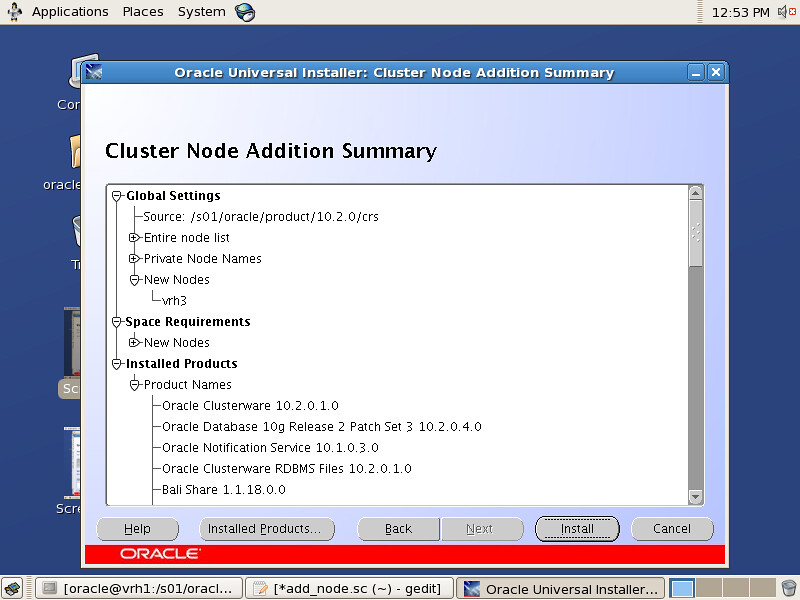
5.出现”Cluster Node Addition Progress”界面,OUI成功将安装好的clusterware软件传输到新的节点后,会提示用户运行多个脚本包括:orainstRoot.sh(新节点)、rootaddnode.sh(运行OUI的原有节点)、root.sh(新节点):
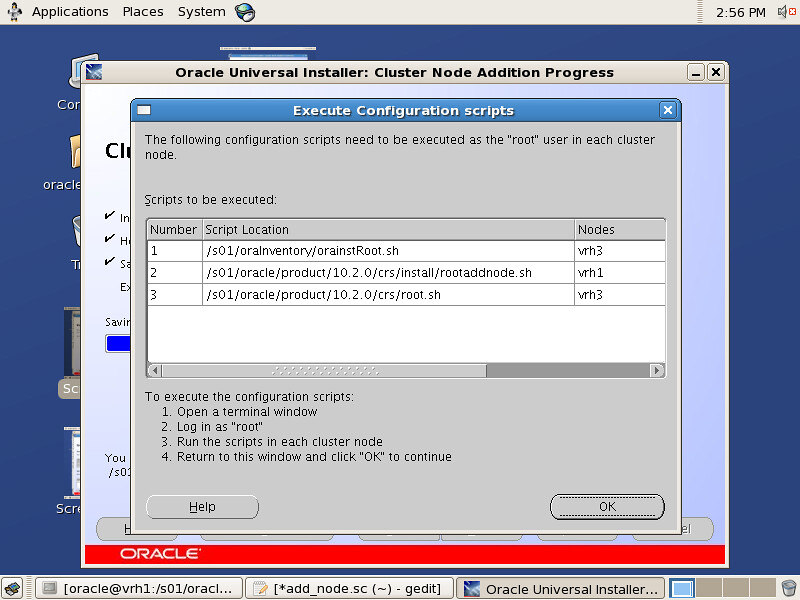
6.运行之前提示的三个脚本:
/* 在新节点上运行orainstRoot.sh脚本 */
[root@vrh3 ~]# /s01/oraInventory/orainstRoot.sh
Changing permissions of /s01/oraInventory to 770.
Changing groupname of /s01/oraInventory to oinstall.
The execution of the script is complete
/* 在运行OUI的原有节点上运行rootaddnode.sh脚本 */
[root@vrh1 ~]# /s01/oracle/product/10.2.0/crs/install/rootaddnode.sh
clscfg: EXISTING configuration version 3 detected.
clscfg: version 3 is 10G Release 2.
Attempting to add 1 new nodes to the configuration
Using ports: CSS=49895 CRS=49896 EVMC=49898 and EVMR=49897.
node {nodenumber}: {nodename} {private interconnect name} {hostname}
node 3: vrh3 vrh3-priv vrh3
Creating OCR keys for user 'root', privgrp 'root'..
Operation successful.
/s01/oracle/product/10.2.0/crs/bin/srvctl add nodeapps -n vrh3 -A vrh3-vip/255.255.255.0/eth0 -o /s01/oracle/product/10.2.0/crs
/* 在新节点上运行root.sh脚本 */
[root@vrh3 ~]# /s01/oracle/product/10.2.0/crs/root.sh
WARNING: directory '/s01/oracle/product/10.2.0' is not owned by root
WARNING: directory '/s01/oracle/product' is not owned by root
WARNING: directory '/s01/oracle' is not owned by root
WARNING: directory '/s01' is not owned by root
Checking to see if Oracle CRS stack is already configured
/etc/oracle does not exist. Creating it now.
OCR LOCATIONS = /dev/raw/raw1
OCR backup directory '/s01/oracle/product/10.2.0/crs/cdata/crs' does not exist. Creating now
Setting the permissions on OCR backup directory
Setting up NS directories
Oracle Cluster Registry configuration upgraded successfully
WARNING: directory '/s01/oracle/product/10.2.0' is not owned by root
WARNING: directory '/s01/oracle/product' is not owned by root
WARNING: directory '/s01/oracle' is not owned by root
WARNING: directory '/s01' is not owned by root
clscfg: EXISTING configuration version 3 detected.
clscfg: version 3 is 10G Release 2.
Successfully accumulated necessary OCR keys.
Using ports: CSS=49895 CRS=49896 EVMC=49898 and EVMR=49897.
node {nodenumber}: {nodename} {private interconnect name} {hostname}
node 1: vrh1 vrh1-priv vrh1
node 2: vrh2 vrh2-priv vrh2
clscfg: Arguments check out successfully.
NO KEYS WERE WRITTEN. Supply -force parameter to override.
-force is destructive and will destroy any previous cluster
configuration.
Oracle Cluster Registry for cluster has already been initialized
Startup will be queued to init within 30 seconds.
Adding daemons to inittab
Expecting the CRS daemons to be up within 600 seconds.
CSS is active on these nodes.
vrh1
vrh2
vrh3
CSS is active on all nodes.
Waiting for the Oracle CRSD and EVMD to start
Oracle CRS stack installed and running under init(1M)
Running vipca(silent) for configuring nodeapps
Creating VIP application resource on (0) nodes.
Creating GSD application resource on (2) nodes...
Creating ONS application resource on (2) nodes...
Starting VIP application resource on (2) nodes...
Starting GSD application resource on (2) nodes...
Starting ONS application resource on (2) nodes...
Done.
7.运行完成以上脚本后回到OUI界面点选OK,出现安装成功界面:
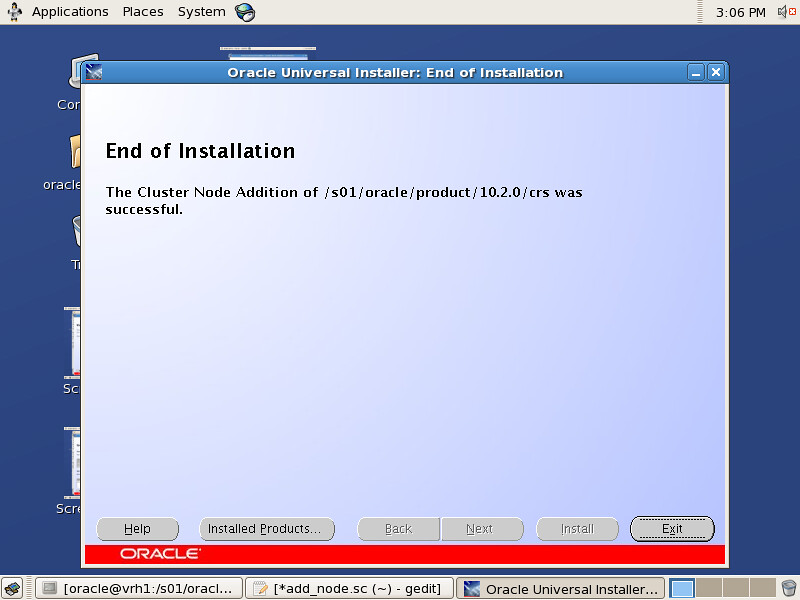
三.在新节点上安装Oracle Database software
1.在原有RAC节点上以Oracle用户身份登录,设置合理的DISPLAY显示环境变量,并运行$ORACLE_HOME/oui/bin目录下的addNode.sh脚本:
[oracle@vrh1 ~]$ export DISPLAY=IP:0.0 [oracle@vrh1 ~]$ cd $ORACLE_HOME/oui/bin [oracle@vrh1 bin]$ ./addNode.sh
3.在”Specify Cluster Nodes to Add to Installation“界面中勾选需要安装Oracle Database software数据库软件的节点,这里为vrh3:
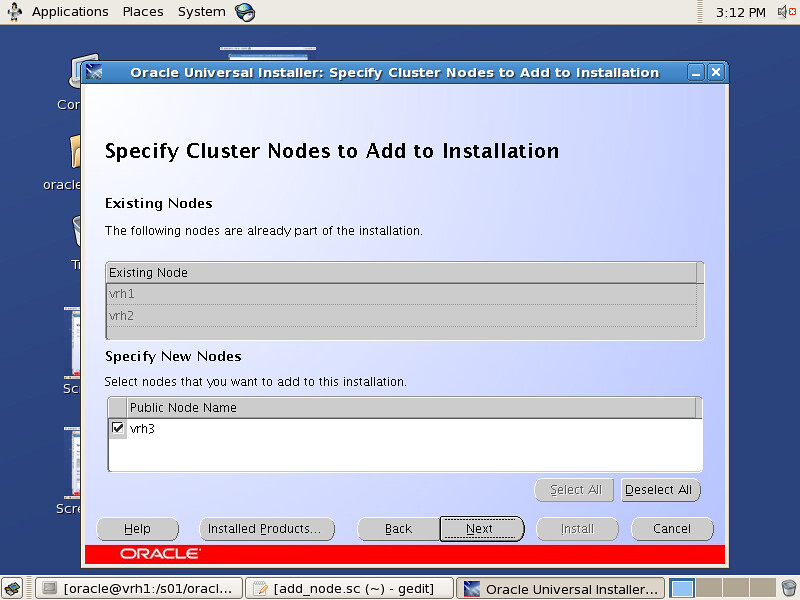
4.出现”Cluster Node Addition Summary”界面,review一遍安装Summary后点击Next:
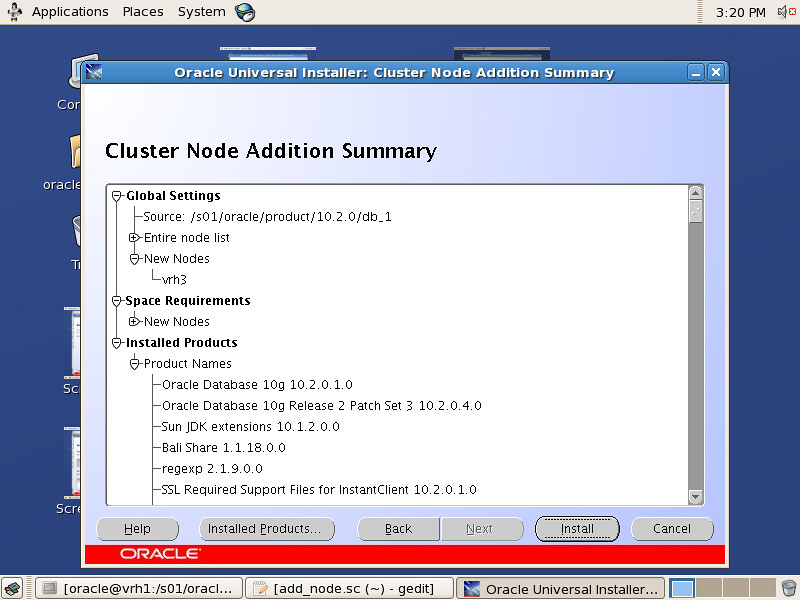
5.出现”Cluster Node Addition Progress”进度条界面,完成对Oracle database Software的远程传输安装后会提示用户运行root.sh脚本:
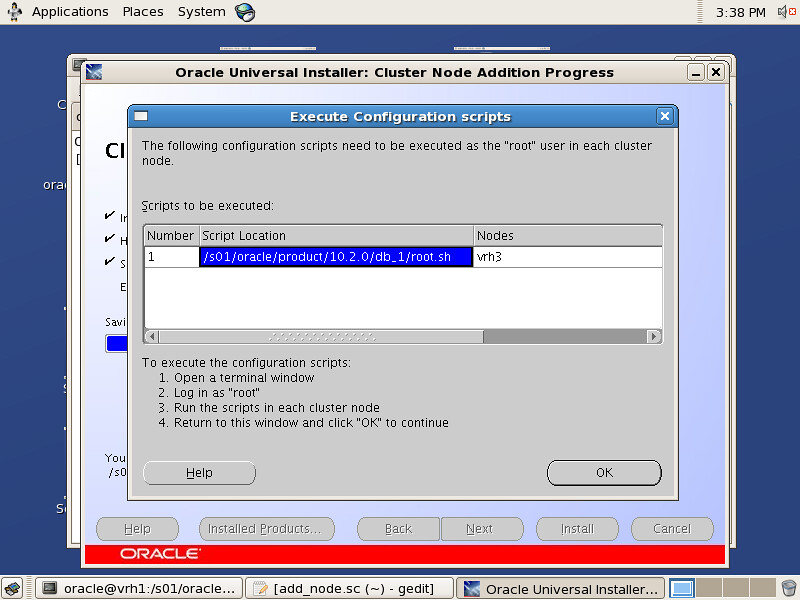
6.在新的节点(这里为vrh3)上运行提示脚本root.sh
四.在新的节点(vrh3)上使用netca工具配置监听器LISTENER,不做展开
五.使用DBCA工具在新节点上添加实例
1.在原有RAC节点上以Oracle用户身份登录,设置合理的DISPLAY显示环境变量,并运行DBCA命令:
2.出现DBCA欢迎界面,选择”Oracle Real Application Clusters”并点击Next:
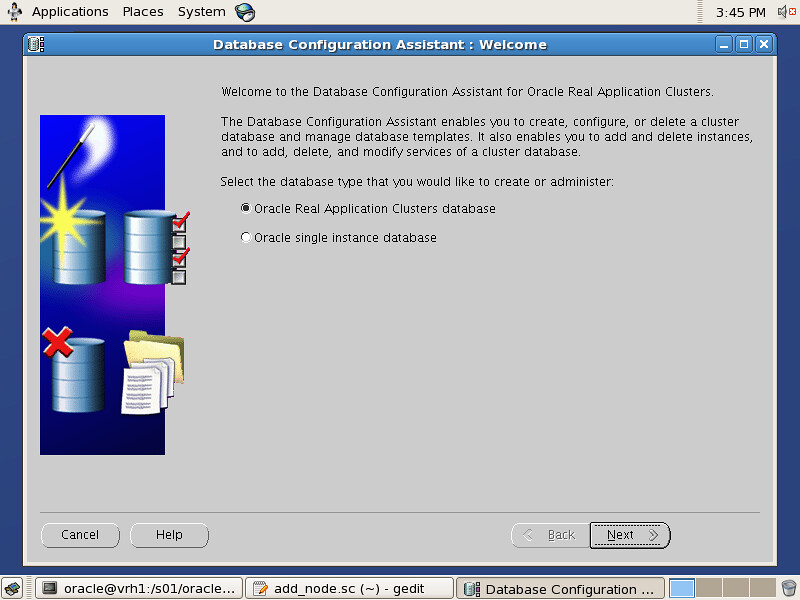
4.勾选”Add an instance”增加节点,并点击Next:
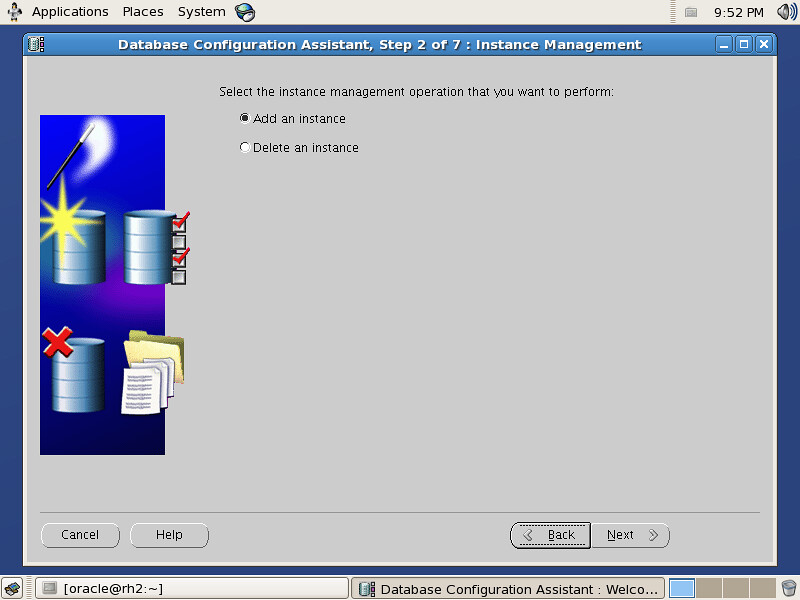
5.勾选想要添加实例的数据库并填写SYSDBA用户信息密码:
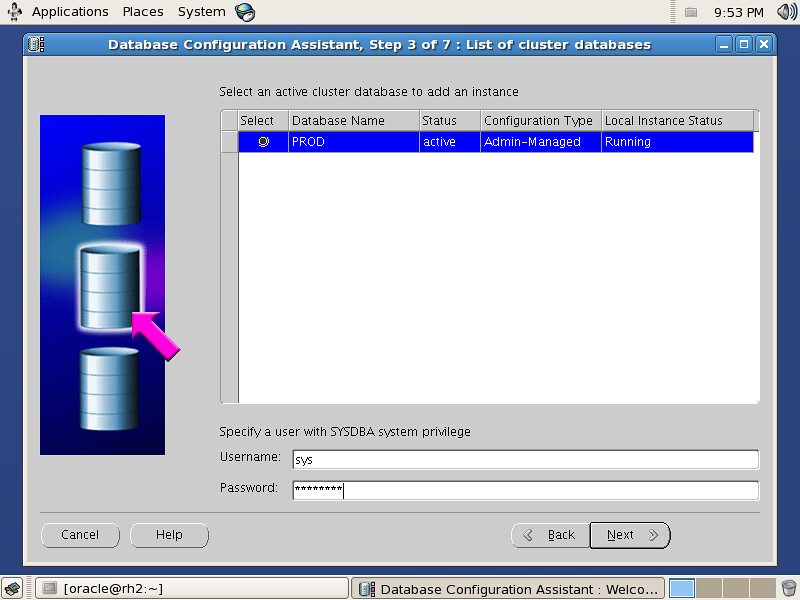
6.勾选正确的实例名和节点,并点击Next
7.Review Storage存储信息,并点击Next
8.Review Summary信息,并点击OK
9.等待进度条完成,当被提示是否执行另一操作”perform another operation”时选择No
10.进一步通过查询gv$instance视图验证节点是否添加成功,若添加成功则当可以看到所有的节点信息。
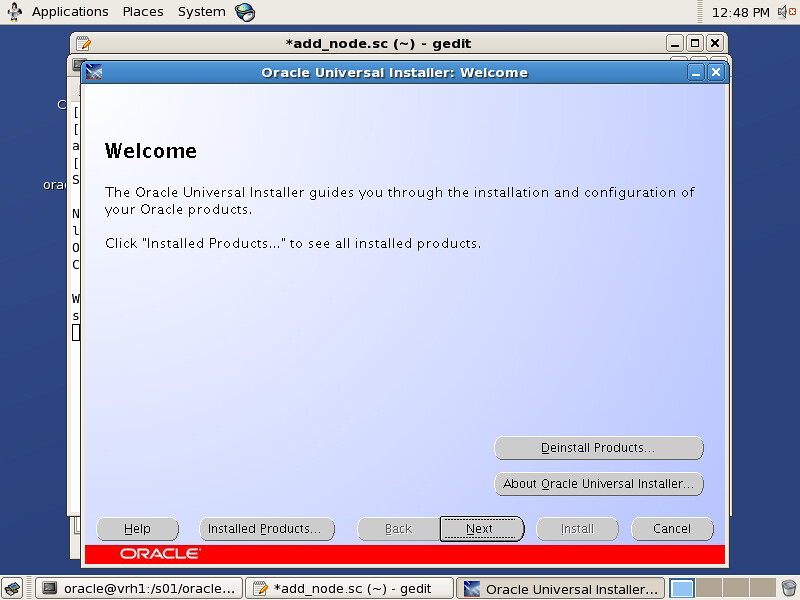
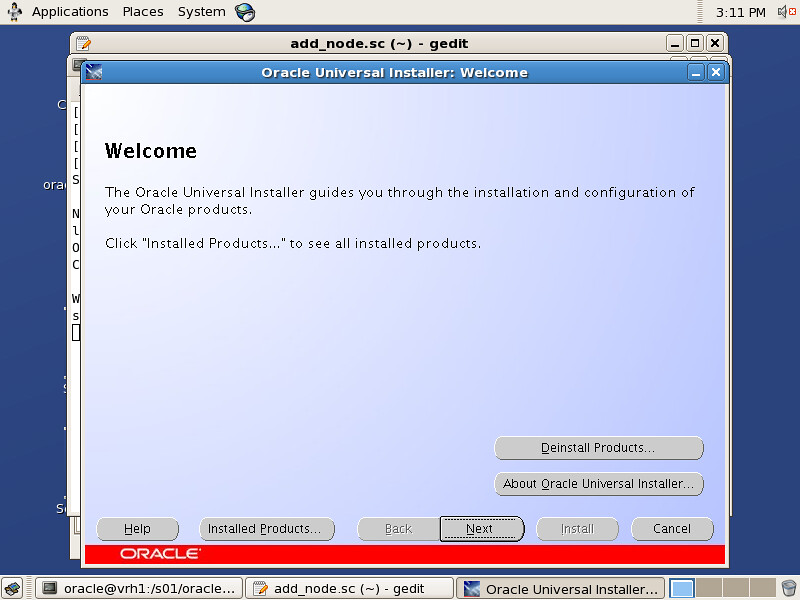
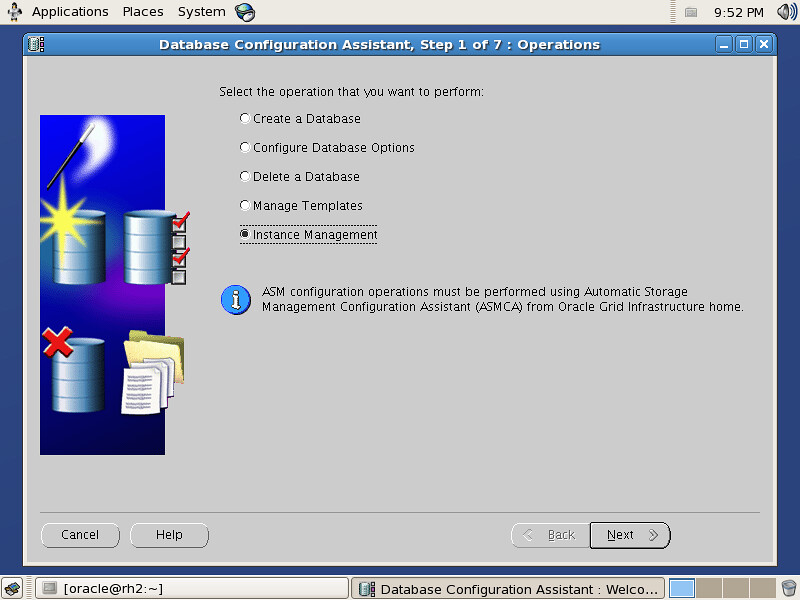

通过DBCA来添加节点的instance 是不是要求 remote_login_passwordfile不能是none?
否则不能验证sys用户?
如果是none怎么办?是手工创建节点的instance还是 改remote_login_passwordfile参数好?
REMOTE_LOGIN_PASSWORDFILE=NONE 相当于密码文件不存在, 建议修改remote_login_passwordfile参数
The 10.2 refrence for REMOTE_LOGIN_PASSWORDFILE specifies that:
“The value EXCLUSIVE is supported for backward compatibility. It now has the same behavior as the value SHARED.”
This is incorrect.The same documentation release for 10.2, in the administration guide specifies the correct behavior:
# NONE: Setting this parameter to NONE causes Oracle Database to behave as if the password file does not exist. That is, no privileged connections are allowed over nonsecure connections.
# EXCLUSIVE: (The default) An EXCLUSIVE password file can be used with only one instance of one database. Only an EXCLUSIVE file can be modified. Using an EXCLUSIVE password file enables you to add, modify, and delete users. It also enables you to change the SYS password with the ALTER USER command.
# SHARED: A SHARED password file can be used by multiple databases running on the same server, or multiple instances of a Real Application Clusters (RAC) database. A SHARED password file cannot be modified. This means that you cannot add users to a SHARED password file. Any attempt to do so or to change the password of SYS or other users with the SYSDBA or SYSOPER privileges generates an error. All users needing SYSDBA or SYSOPER system privileges must be added to the password file when REMOTE_LOGIN_PASSWORDFILE is set to EXCLUSIVE. After all users are added, you can change REMOTE_LOGIN_PASSWORDFILE to SHARED, and then share the file.
这样的话如果RAC下设置了shared 模式,那删除/增加SYSDBA权限用户,都得先把这个参数改到exclusive,做完操作再改回shared了。
由于这个参数是静态参数,那不是每个节点都得restart一次。
你好,我看了你这个10g 增加节点。不知道这个增加节点是在线完成的?还是那两个节点都关闭之后才进行的这个操作?麻烦回复下,谢谢!
文章中没有说需要关闭原节点的操作,那么就是不需要,如果需要我会写明。
感谢刘大的文档。 我用裸设备建的库。 在dbca的时候,遇到了需要undo和redo裸设备的问题,前期准备的时候忘记创建了。 用asm的情况应该会好些。其他按文档操作一切正常。再次感谢。